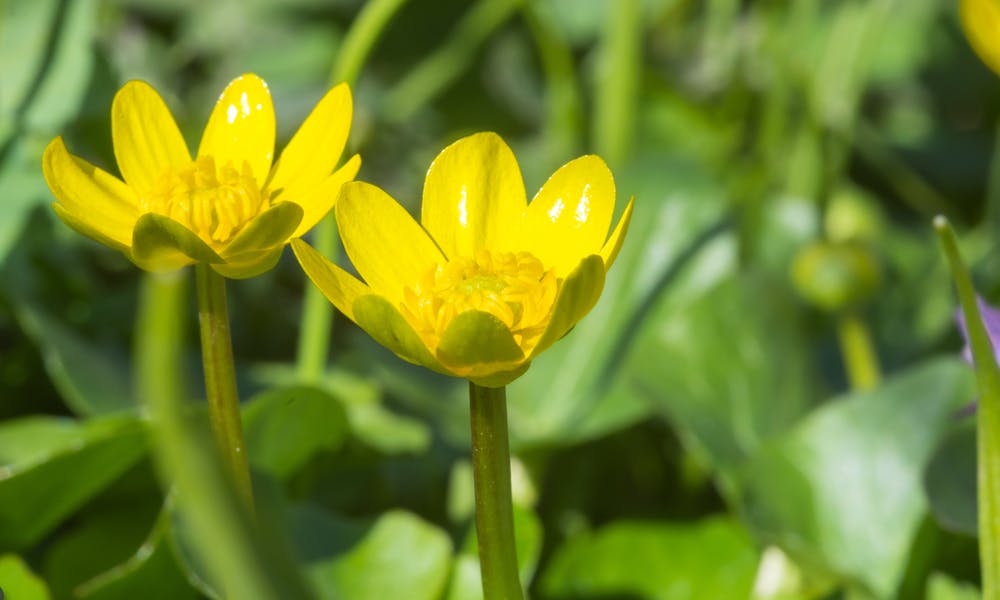The Ranunculus flower is a mostly perennial flowering plant whose distinctive shiny yellow petals, formed by the layer of air it contains between the petals, and cup-like shape gave rise, supposedly, to its nickname buttercup. Some of its lesser-known names are spearwort and water crowfoot, which we can agree are not as pleasant sounding. Found mostly in warmer climes, this charming flower is a popular addition to bouquets and flower gardens, especially when placed near any water sources.
Keep reading to find out the:
- Origins of the buttercup flower
- Buttercup anatomy
- common varieties
- Cultural symbolism
- Fun facts
- Use in food and medicine
- Raising a buttercup
Origins of the Buttercup Flower
The buttercup flower is native to many parts of Europe, especially in the northern latitudes. It is thought to have originated in Greece, Turkey, and Iran. It was brought over to North America and now can be found in many states. Some forms are found in parts of Asia. Its name, ranunculus, stems from the Latin word for “little frog,” probably due to many of the flowers being found near the water. There are close to 500 species of buttercup in existence that can trace their ancestry back millions of years. Most of the flowers are pollinated by bees who are drawn in by its glossy exterior to be rewarded by its nectar.
Buttercup Anatomy
Although many of the flowers are perennial, a few are annual and biennial as well. It can grow alone or sometimes in pairs. The most common color that it draws its name from is yellow, but pinks, reds, golds, and whites can be found as well. The reflective petals, usually coming in groups of five, attract pollinators. Most buttercups have stems, do not have stipples, and generally contain their leaves in a rosette near the bottom of their stems. It can grow up to 14 to 16 inches tall with some varieties having a flower span of up to 12 inches wide. Most buttercups have multiple pistils in their center, with a very noticeable hook shape at the end. The flowers generally blossom in late spring to early summer.
Common Varieties
There are many varieties of flower types within the ranunculus genus. Some of the more well-known include the meadow buttercup, with its long, graceful stem ending in perfect yellow petals, the glacier buttercup, bearing a very wide set of petals in a creamy white color, the meadow buttercup, which has been introduced to most parts of the world as well as the Persian buttercup, which has distinctive, beautiful red petals that are quite hairy. Some others like the sagebrush and straight break butter flowers are very popular in simple bouquets.
Cultural Symbolism
Most cultures associate the buttercup with playfulness, childishness, charm, and humility, not surprising considering its nickname. It has also been known to be associated with neatness and being ungrateful. In the united states, the flower has been called coyote’s eyes. An old children’s game, still in play in some countries, was to place the reflective petals of the buttercup under someone’s chin and if the chin reflects the yellow color you are said to enjoy butter amusingly enough.
Fun Facts
Although the origin of the name buttercup is not set in stone, an old myth says that a singer named Ranunculus fell in love with a wood fairy. While singing her a song he put all his energy into it and fell dead after. The flower, which grew from his resting place was named after him in his honor. There is also a tale told of a farmer finding that one of his cows gave the sweetest milk and noticed that she happened to eat a particular flower in large amounts, hence he named the flower buttercup. Old folk stories are always enjoyable to find, and the buttercup has a bunch more to find around the world.
Use in Food and Medicine
There is no buttercup cuisine. Eating any kind of ranunculus flower is not recommended, as they are highly poisonous when fresh. Keeping them as far away from livestock and pets is recommended, as they are deadly to them as well. If you happen to be the adventurous type, a simple taste is considered safe, although you must spit out the flower immediately, not difficult considering its bitter flavor. There is some tradition of using parts of the plant in medicine to help with fevers and joint issues, skin diseases and gout, but the medical community does not recommend this.
Raising a Buttercup
Not the ideal flower for snowy environments, the buttercup is relatively easy to raise. It needs lots of sunshine, and moist soil, although not too wet. The tubers must be planted with the roots facing downwards. They require a few inches of space between each bulb to flourish and are best soaked before planting. If you happen to be in a spot that has frost, you may have to pull out the tubers and store them indoors, making sure to let all the water evaporate off them first, then place them in a dark environment to help keep them alive until you can replant them again the next season. If the temperature and environment are right and mulching is done lightly, these flowers can last for quite a few years.
The Lustrous Buttercup
When looking for the right flower to add to a home, it can be a difficult journey. Thinking of the weather, the location, and what a flower matches with is time-consuming. That being said, the buttercup is a lustrous addition to any garden, whether your tastes run towards the more well-known yellow-colored meadow flowers, the mysterious Persian buttercup with its hairy, red petals or the aptly named glacier buttercup, it is a fun way to spruce up your home or simply to give as a fun gift to your children.
